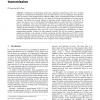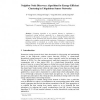545 search results - page 62 / 109 » Minimum energy accumulative routing in wireless networks |
EJWCN
2010
13 years 3 months ago
2010
Simulation studies have been the predominant method of evaluating ad hoc routing algorithms. Despite their wide use and merits, simulations are generally time consuming. Furthermo...
CORR
2007
Springer
13 years 8 months ago
2007
Springer
: Collaborative beamforming (CB) and cooperative transmission (CT) have recently emerged as communication techniques that can make effective use of collaborative/cooperative nodes ...
EUC
2005
Springer
14 years 2 months ago
2005
Springer
Clustering algorithm is an essential element to implement a hierarchical routing protocol, especially for a large-scale wireless sensor network. In this paper, we propose a new typ...
APCHI
2008
IEEE
14 years 3 months ago
2008
IEEE
Routing through a backbone, which is responsible for performing and managing multipoint communication, reduces the communication overhead and overall energy consumption in wireless...
SECON
2008
IEEE
14 years 3 months ago
2008
IEEE
—The novel cross-layer protocol Breath for wireless sensor networks is designed, implemented, and experimentally evaluated. The Breath protocol is based on randomized routing, MA...


